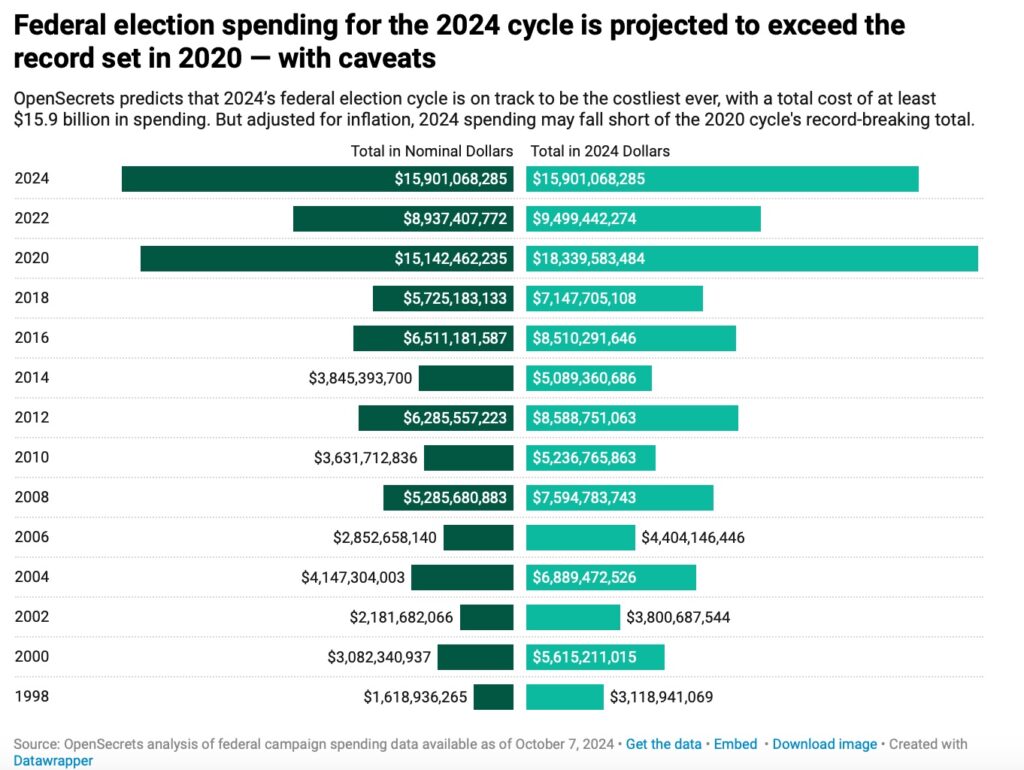By SARAH BRYNER AND BRENDAN GLAVIN | OPEN SECRETS
With three weeks left until Election Day, OpenSecrets predicts that 2024’s federal election cycle is on track to be the costliest ever, with a total cost of at least $15.9 billion in spending. This will surpass the 2020 cycle’s record-smashing total of $15.1 billion.
Outside groups, largely super PACs, have spent roughly $2.6 billion on 2024 federal elections, outpacing spending in any previous cycle. If the current spending trends hold, OpenSecrets projects that total outside spending for the entire election cycle will exceed $5 billion.

This staggering price tag of the 2024 election cycle comes with caveats. Inflation between 2020 and 2024 has been significant. When adjusted for inflation, the 2020 total fundraising total would be the equivalent of $18.3 billion in 2024 dollars.
2020 presidential primaries were significantly more expensive
Former NYC Mayor Michael Bloomberg ran for the Democratic presidential nomination in 2020 and singularly spent $1 billion of his own money on the race during a short 30-day period before dropping out on March 4th, 2020.
In contrast, neither Vice President Kamala Harris nor former President Donald Trump are expected to have spent or raised $1 billion through the end of September.
Combined, Bloomberg and fellow 2020 Democratic presidential candidate Tom Steyer spent over $1.4 billion in their own funds to self-finance their 2020 primary campaigns. Even without factoring in that unprecedented influx of self-funding, Democratic candidates in the 2020 primary still outspent Republican candidates in the 2024 Republican primary by about $500 million.
2024 presidential general election fundraising trends
Fundraising trends are moving in different directions for Harris and Trump. The replacement of President Joe Biden with Harris on the ticket has spurred an enormous boost in fundraising on the Democratic side.
While Harris has not announced September fundraising totals, Harris and the Democratic Party are projected to have raised about $1 billion or more from July through September, based on information provided by the Harris campaign documenting weekend fundraising totals, and what they reported for July and August.
Trump and the Republican Party raised $430 million over the same period, including fundraising totals announced by the campaign and party committee for the month of September as well as what was reported to the FEC in prior months. If fundraising trends continue, this will likely result in Harris exceeding the Biden campaign’s 2020 receipts, while Trump may struggle to match what his campaign reported in 2020.
Going into the final stretch before Election Day, the Harris campaign has not yet reported its fundraising totals from September, but as of the end of August, Harris and the Democratic Party reported $404 million cash on hand. Trump and the Republican Party reported having $283 million at the end of September. Based on previous trends OpenSecrets expects this to be spent before Election Day, in addition to money that will be raised during October, which could easily exceed another $500 million. OpenSecrets analysis of FEC data from 2020 shows the two general election campaigns, along with the RNC and DNC, combined to spend over $1.1 billion between Oct. 1 and Nov. 23.
Outside spending is up, favoring Republicans
As OpenSecrets has reported, outside spending for 2024 is well outpacing previous cycles.
As of Oct.7, outside spending — largely through independent expenditures purchased by super PACs and hybrid PACs — reached $2.6 billion, nearly a billion dollars more than outside groups had spent by the same point in 2020. With a full month of spending yet to be reported, OpenSecrets projects that 2024 outside spending will surpass 2020 spending before Election Day, even accounting for inflation.
This outside spending significantly favors conservatives so far, a switch from 2020 where liberal groups spent more money than conservatives. As has now become standard, the groups spending the most money are the presidential-candidate-linked super PACs with Make America Great Again Inc. spending over $239 million supporting Trump, while Future Forward has spent over $212 million supporting Democratic presidential candidates.
Cryptocurrency-linked super PAC Fairshake and its affiliates have spent $123 million supporting both Democratic and Republican candidates, an unusual pattern among top-spending super PACs.
While outside spending groups are generally required to disclose donors to the Federal Election Commission, there are exceptions.
Future Forward, the pro-Harris super PAC, discloses donors to the FEC but its top donor is a dark money nonprofit organization, Future Forward USA Action and therefore is classified by OpenSecrets as a partially disclosing organization.
On the congressional side, each of the four super PACs linked to party leadership are also partially-disclosing groups. Combined they have reported receiving nearly $72 million in contributions from their affiliated dark money groups. This obfuscation of the true source of funds to super PACs is a commonly used method by political groups to bypass meaningful disclosure, and we continue to see significant spending by non-disclosing groups.
Congressional races seeing more money than in 2020
While the race to the White House typically dominates coverage during presidential cycles, 2024 congressional candidates are also attracting record spending. The limit for donations from individuals to candidates increased from $2,800 to $3,300 per election over that four-year time period. This means that over an election cycle an individual can now give $1,000 more to a federal candidate than they could four years ago.

With the Senate held by Democrats and the House by Republicans, both parties hold spending advantages in the chamber they hold.
In the House, the spending gap is small. But in the Senate, Democrats have outspent Republicans by over $150 million. In every swing Senate race, the Democratic candidate has raised/spent at least 75% more than their Republican counterpart, including races where neither candidate is an incumbent.
While Republicans have currently outspent Democrats in the lower chamber, this trend might not hold in the next few months. Democrats running in the general election have collectively outraised Republicans, hinting that Republicans may have faced more active primaries or spent more of their money earlier.
Democrats running in the general election have, on average, about $175,000 more cash on hand than Republicans. This generally includes fundraising through the end of June with some candidates in later primaries having reported more recent fundraising information.
Where does the money come from?
While Bloomberg is not spending money on his own campaign this cycle, he still ranks among the cycle’s top donors – behind five conservative donors. This is the first cycle where the top 5 megadonorsare all supporting Republicans, contributing to a major fundraising advantage conservative outside spending groups have seen so far.
The top 10 individual donors have contributed $599 million – 7% of all money raised – thus far for the 2024 cycle. Extending the list to the top 100 donors shows that they account for 16% of all fundraising, and extending it further to the top 1% of all donors accounts for a full 50% of all money raised. In contrast, all donors giving under $200 account for just 16% of all money raised. With conservative groups outpacing their liberal counterparts in outside spending this cycle, it is no surprise that the top five individual donors to outside groups are conservative givers.
The total fundraising from small donors, as an overall percentage of fundraising, has hovered around 20% for several presidential cycles with a notable uptick in the 2020 cycle.
Democrats running for federal office in 2024 have taken substantially more from small donors giving under $200 than their Republican counterparts. So far, 28% of donations to Democratic candidates are from small donors, compared to 19% to Republicans.
Doug Weber, Dan Auble, Andrew Mayersohn, Olivia Buckley and Anna Massoglia contributed to this report.
Methodological Notes:
In estimating the final total cost of the federal election for 2024, OpenSecrets used the 2020 election as a guide for predicting how much money remains to be spent. Some extenuating circumstances from 2020 were excluded. First, the extraordinary infusion of self-funding, $1.4 billion, from Michael Bloomberg and Tom Steyer in the 2020 Democratic primary would have artificially inflated our calculations and it was excluded. Additionally, approximately $500 million was spent after the general election in 2020, specifically on the two Georgia runoff races that were held in early January 2021. We do not expect a similar situation to happen this year and therefore we removed that spending from our calculation of what we expect to be spent going forward.

Every bit should have went to Americans in need or the national dept.
Free speech?